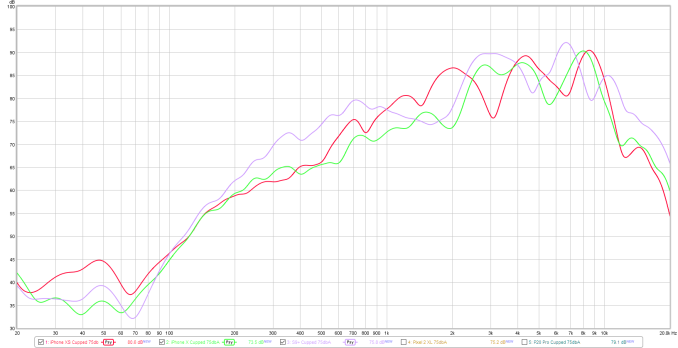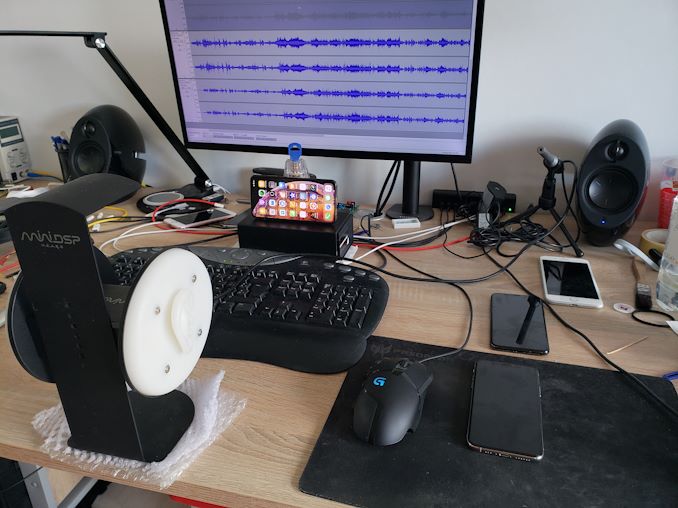The iPhone XS & XS Max Review: Unveiling the Silicon Secrets
by Andrei Frumusanu on October 5, 2018 8:00 AM EST- Posted in
- Mobile
- Apple
- Smartphones
- iPhone XS
- iPhone XS Max
Camera Video Recording
In terms of video recording, the iPhone XS promises an improved dynamic range in modes up to 30fps. What this likely means is that the phone’s able to capture in HDR mode in the 30fps modes, doing the same kind of processing we also see in SmartHDR still pictures.
Also something I’ve dreaded on iPhones for years; the new iPhone XS finally introduces stereo audio recording. Why it took Apple such a long time to finally introduce stereo recording is something that boggles the mind, but, let’s not complain, as we now finally have it on the new generation.
iPhone XS: iPhone X:
Comparing the iPhone XS video to the iPhone X, there’s one thing that is immediately very evident: the new XS is able to produce much better image stabilisation than last year’s flagship. Indeed, it looks like Apple vastly improved the OIS/EIS on the new phones, as the wobble that happens when walking is gone on the XS.
Audio recording finally is up to par, and we can hear the wind and rustling leaves of the trees around us. I think Apple might still have to work a bit on the wind noise cancellation, as in some parts the audio sounded as if it was inside a tube.
In terms of image quality, Apple’s claims of the improved dynamic range are very much verified. The phone showcases a lot more brought down highlights in the scene, and in darker areas, show better shadows. It’s unfortunate that this is limited only to the 30fps modes, but it’s understandable.
Switching over from the main lens to the telephoto lens happens relatively fast, although with a short exposure flash and a slight delay on the first zoom. 4K60 recording doesn’t allow for the use of the telephoto lens.
All in all, the video recording quality of the new iPhone XS is massively improved in all areas of stabilisation, picture quality, and audio. 4K30 recording on the XS is probably the best I’ve seen on any smartphone – a definitive applause to Apple for the improvements here.
Speaker Evaluation
Apple claimed to have improved the speaker audio quality on the new iPhone XS, allowing for more stereo separation and filling sound. I had introduced a new speaker evaluation method a few months ago because this year’s efforts by smartphone vendors to improve speaker quality has been very pronounced, and I wanted to have a way to objectively convey these improvements.
Starting off with speaker loudness, we’re measuring the phones at maximum volume, both in one-hand portrait mode, as well as two-handed mode where the palms are cupped towards the user. These two use-cases are what I find myself most often using the phone’s speakers in, so hopefully that also represents how most users use it as well, please let me know otherwise!

Using a pink noise signal, the iPhone XS pretty much falls into line with the results of the iPhone X, coming in at a very loud 82.8dBA in portrait mode and 87.6dbA in two-handed mode. Apple’s sound directionality on the iPhone X and XS is among the best, most likely due to the fact that the stereo earpiece is among the loudest of current generation smartphones.
Measuring the frequency response of the speakers, we see the iPhone XS closely following the measurement of the iPhone X, however there’s a major difference in the mid-range where the XS is around 5dB louder, raising instrumental frequencies and voices. This difference is what I think Apple is referring to when talking about better “fullness”, as it is evident when playing back media.
To better demonstrate the difference between the phones, I’ve attempted to capture them with a binaural microphone setup. Now I know my environment isn’t perfect as I don’t have the necessary sound dampening equipment, but I hope it does serve as an overall adequate A/B comparison between the phones. I’ve tried to calibrate the sound as much as possible recorded by the setup to a flat frequency response, although I’m sure there are improvements to be made. As a comparison, I also included calibrated speakers as a baseline to get an idea of the microphone setup.
The audio is meant to be listened to with headphones, or even better with IEMs, as this will give the intended playback of the binaural recording.
The iPhone XS’ improvements in the mid-range are quite evident as voices sound deeper and more pronounced on the new phone. Stereo separation is also quite good – resulting in a filling audio experience.
I included the S9+ and G7 as comparison devices. Samsung still does a significantly better job at the low-mid ranges which gives the phone more overall presence than the iPhones, also has an advantage in the very high frequencies giving more clarity, however the new iPhone’s XS strength point in the mid-ranges is the S9’s weakness, and vocals sound a lot less present than on the XS.
As for the G7, I just wanted to showcase a mono speaker device, and just how huge the audio difference is. Unfortunately the G7, even though it promises to have a good speaker, fails in practice.












253 Comments
View All Comments
patel21 - Saturday, October 6, 2018 - link
Exactly. In India we have a new Carrier service called Jio doing exactly the same. They built their network group up on VoIP and only sell data. Calls and SMS are totally free.And man can you imagine I am using their plan of 2GB data per DAY for 90 days at just USD 8 !!!
phoenix_rizzen - Friday, October 5, 2018 - link
You mean Qualcomm, not 3Com. :)bull2760 - Sunday, October 7, 2018 - link
Yes thank you sorry meant Qualcomm, my bad.varase - Friday, October 5, 2018 - link
I just downloaded 12.1 Developer Beta 2 and in my 2 bar AT&T household, I went up from about 11 mbps to 38 mbps.My local cell tower probably doesn't have 4x4 mimo, though my Orbis are pushing 298 mpbs through wifi and saturating my internet link.
It's a little early to jump ship - there's bound to be a few rough edges that'll have to get filed down :-).
Speedfriend - Monday, October 8, 2018 - link
What, your mobile data speed has been only 11mbps, where do you live? How on earth do you use your phone like that! I regularly get over 100mbps where I live in London, with the highest I have recorded being 134mbpsbull2760 - Sunday, October 14, 2018 - link
Little early to jump ship. Do you remember antennagate? Steve Jobs answer to a design issue, “you are holding the phone wrong”. Sorry not forming out 1500 for a phone that has cellular as well as network related issues. How this ever passed inspection in testing is beyond me. I’m an Apple fan, have owned every iPhone since they started making them. This is without a doubt the worst performing iPhone I ever purchased. Yes it was snappy and apps flew open. But if I can’t use the phone aspect or wireless networking at home, I may as well hold a paperweight to my ear. I’m heavily entrenched into the Apple ecosystem. Watches, TV, iPads and MacBook Pro. Not to mention all the movies, music and apps that I’ve purchased. This pisses me off. 1500 for a piece a shit phone that was not properly tested before being released.Marlin1975 - Friday, October 5, 2018 - link
The thing that jumps out to me is the power usage and performance gains at the same time. TSMC's 7nm process looks really good. I wonder if this will also play out on CPUs/GPUs on the same process coming soon.melgross - Saturday, October 6, 2018 - link
It’s hard to say how much of what Apple gets out of these processes others will get. Apple has bought a lot of equipment for TSMC, as they’ve done for other companies, including Samsung, over the years. What they get out of it is early access to new processes, as well as some more specialized features that they have often developed themselves, as well as extra discounts.KPOM - Friday, October 5, 2018 - link
Intel should be worried.varase - Friday, October 5, 2018 - link
I still think the star of the show may end up being the neural processor, up from 660 billion ops/sec to 5 trillion (9x the speed at a tenth the energy usage) - now available to developers via Core ML 2, and now pipelined through the ISP.